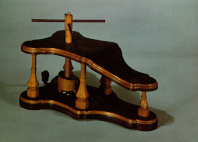
26.8 x 25.1 x 39
Carved wood and brass
INDEX 1788 : D.II.143
Ergata cum quatuor palangis axem permeantibus ad onera movenda. Huic additur planum inclinatum, cujus ope funis libere atque impune circumvolvitur.
Capstan with four drums crossing an axle, for moving weights. To this an inclined plane is added, with the help of which a rope can wind freely.
A capstan is an apparatus for winding a rope bearing a weight around a vertical axis. The capstan in the museum consists of a vertical cylinder which rotates by means of a cross-shaped set of four levers on the upper end of the axle. The cylinder rests in a circular cavity in the base of the apparatus, and passes through a hole in a platform above, which is supported on five octagonal columns.
Surrounding the axle of the capstan, and joined to the lower end, there is a wooden cylinder, spiral at the top, which rests in grooves on the base of the apparatus. At the bottom of the cylinder is a piece of brass which engages with a cogwheel which moves together with the capstan axle. This device allows the axle to turn in one direction only, thereby preventing the rope around it from unrolling.
On the base of the apparatus there is a brass pulley to guide the rope pulling the weight. On the opposite side from the pulley a second cylinder may be fitted, parallel to the capstan axle: the rope coming from the capstan would go once around this before being taken up, which would give greater strength to the capstan when in use.
The helicoidal top of the cylinder, through which the capstan passes, delineates two different levels for the traction rope. The section of rope coming from the pulley wheel is at a lower level than the section which is going to the second cylinder, if mounted, or which is being pulled by the operator. In this way the two sections of the rope are prevented from rubbing against one another.
From Colégio dos Nobres, catalogue n.º 134.
Musschenbroek, Peter van, Introductio ad Philosophiam Naturalem, Leiden, 1762, Vol. I, § 452, Tab. II, Fig. 3.